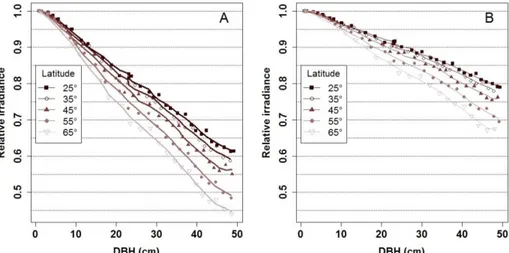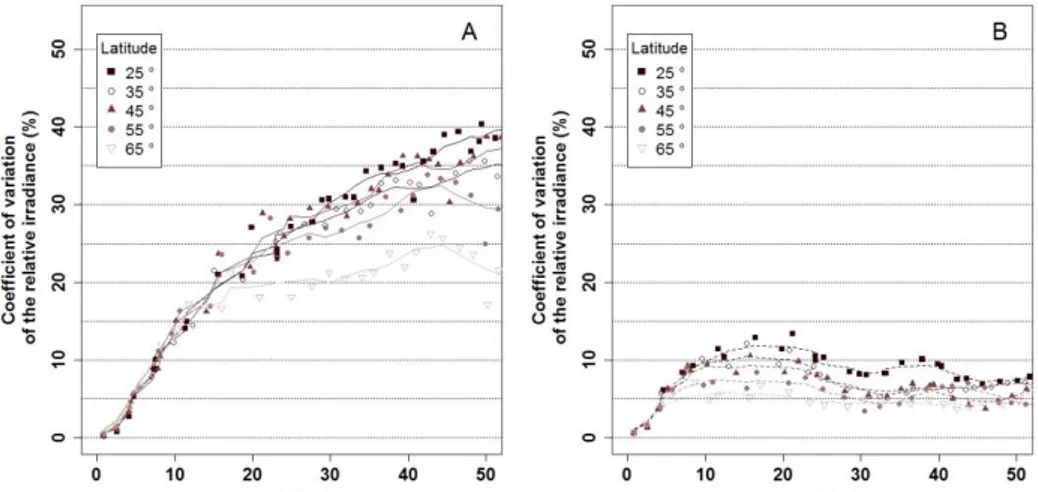HAL Id: hal-02742594
https://hal.inrae.fr/hal-02742594
Submitted on 3 Jun 2020
HAL is a multi-disciplinary open access L’archive ouverte pluridisciplinaire HAL, est
best designs to allow more light to the crops at various
latitudes
Christian Dupraz, Isabelle Lecomte, Quentin Molto, Céline Blitz-Frayret,
Marie Gosme
To cite this version:
Christian Dupraz, Isabelle Lecomte, Quentin Molto, Céline Blitz-Frayret, Marie Gosme. Agroforestry at all latitudes? Unexpected results about best designs to allow more light to the crops at various latitudes. 3. European Agroforestry Conference (EURAF 2016), May 2016, Montpellier, France. 466 p. �hal-02742594�
AGROFORESTRY AT ALL LATITUDES? UNEXPECTED
RESULTS ABOUT BEST DESIGNS TO ALLOW MORE
LIGHT TO THE CROPS AT VARIOUS LATITUDES
Dupraz C.1*, Lecomte I1, Molto, Q.1, Blitz-Frayret, C.1, Gosme M.1
* Correspondence author: christian.dupraz@montpellier.inra.fr
(1) INRA, UMR 1230 System, Montpellier, France
Introduction
Why are high latitude farmers so reluctant towards agroforestry? Competition for light between trees and crops is the greatest fear of most farmers when considering agroforestry adoption (Graves et al., 2009). It is usually assumed that this competition for light would be very detrimental to the crops at high latitudes (above 45° Latitude). Current agroforestry practices in Europe are mostly maintained at Southern Mediterranean latitudes (Eichhorn et al., 2006), and agroforestry is more successful in the tropics than in the temperate world (Ong et al., 1991). Both facts may support that radiation availability is limiting agroforestry adoption at high latitudes. Another recent assumption is that North-South tree lines should be preferred to allow for a more homogeneous irradiation of the crops in the alleys at temperate latitudes (Dufour et al., 2013). However, the effect of trees on light availability for the crop can be very different at different latitudes because of different day length and sun trajectories. Using a numerical simulation model, we question these paradigms, and look for their validity domain at different latitudes.
Material and methods
Direct field experiments involving latitude are not feasible. We therefore decided to adopt a virtual experiment approach, using a process based model of agroforestry systems. We used the Hi-sAFe model that includes a 3D light competition module between trees and crops. This light module was previously validated with field observations (Talbot and Dupraz, 2012). The model is spatially explicit, allowing comparing various planting designs including tree density, tree rows orientation, plantation design (rectangular, quincunx) and pruning intensity. We computed the radiation available for crops in an alley-cropping system at five latitudes (25°, 35°, 45°, 55°, 65° Lat North ), two distances between tree lines (17 versus 35 m) and two tree row orientations (North-South, East-West). Trees were spaced 7 m on the tree line, resulting in a planting density of 84 and 41 trees.ha-1 with the 17m crop alley and 34m crop alley
respectively. We calculated the relative irradiation of the crop (ratio of incoming radiation at the crop level divided by the incoming radiation on the plot) at the day time step and m² scale, and aggregated it at various time (month, year, decades) and spatial (m², cropped alley, total plot) scales. Spatial variability was calculated as the coefficient of variation of the relative irradiation of the 1-m² cells of the cropped alley. To assess seasonal effects, we also computed the irradiation of the crops at some key times of the year. The simulations were run until the trees had reached 50 cm Diameter at Breast Height (DBH) at all sites, allowing comparing the relative irradiation of the crops with the same DBH for all trees. The simulated trees were deciduous trees (walnut type) with the same pruning scheme (every two years, 30% of tree height, up to 4m).
Results and discussion
Intensity of crop irradiation.
Tree density affected crop relative irradiation at all latitudes (Figure 1) with higher levels for more widely spaced trees.
Figure 1: Variation of the annual relative irradiance at crop level as a function of tree size at 5 levels of latitude (East-West tree line orientation at 17 m (A) and 35 m (B) between tree lines).
Relative irradiation was lower at high latitudes, but did not vary much between the tropics and temperate latitudes. It is sometimes assumed that crops adapted to shady environments may cope with up to 50% of reduction of the irradiance, and will perform with no yield decrease at 80% relative irradiance (Ong et al., 1991). With 41 trees.ha-1 (35 m between
tree lines), the 50% threshold was never reached at all latitudes (Figure 1B), showing that agroforestry should be feasible at high latitudes with widely spaced tree lines. With 84 trees.ha-1
(17 m between tree lines), the relative irradiation of the crops remained above 60% for the whole cycle at low latitudes, and for more than half the tree life cycle at very high latitudes (Figure 1A). However annual values may not be sensible when discussing the behaviour of crops with short growing seasons. We therefore zoomed in on targeted periods of the year (Figure 2) with very large mature trees (50 cm DBH).
Surprising patterns of radiation capture by the trees are evidenced. The practical result is not trivial: to increase radiation availability on the crops, East-West tree lines are better at low (tropic) latitudes, North-South tree lines at high latitudes, and there is no clear preference at temperate latitudes. This is at odds with the common sense and previous knowledge. The relative irradiation of crops decreased with latitude at all periods of the year except in June with North-South tree lines, where it remained almost constant between 25 and 45° latitude. For summer crops, East-West tree lines should not be used at high latitudes, as the late summer irradiation of crops was low with such a tree row orientation.
Heterogeneity of crop irradiation.
Farmers need to grow crops as homogeneous as possible, so that all management practices (in particular harvest) can be done on the whole alley at the same time. If crop irradiation is too heterogeneous, some parts of the crop may be ripe when other parts are not. Heterogeneity of irradiance at crop level increased steadily with tree size (Figure 3A) for East-West tree lines, while North-South tree lines (Figure 3B) lead to a higher homogeneity of the relative irradiation. With North-South tree lines, heterogeneity peaked with medium sized trees and then stabilized at a lower level for larger trees. Our simulations showed a higher homogeneity of the crop relative irradiation with 35 m spaced tree lines, although the difference between the most sunny and the most shaded locations was maintained (results not shown).
Figure 3: Heterogeneity of crop irradiation expressed by the coefficient of variation for the month of June of the relative irradiation for 17m wide alleys with East-West tree lines (A) and North-South tree lines (B).
Conclusion
It may not be safe to draw conclusions with only relative irradiation values. Absolute incoming irradiance also decreases with latitude, and this may result in levels of absolute radiation that would be limiting for the crops, even when the relative irradiation is high. The total annual radiation is reduced at high latitudes, but this is not true at all times of the year. At the summer solstice, the incoming irradiance is quite uniform across latitudes. At high latitudes, summer crops are the rule, and they will therefore benefit from high levels of irradiation even in agroforestry systems during the summer. Practical rules can then be inferred from our simulations results, based on a mature tree DBH of 50 cm (Table 1). Agroforesters want more light and less light heterogeneity on their crops, but they also want a fast growth of the trees. Our simulation results could allow finding a compromise between these requirements based on numerical estimation of crop and tree growth.
Table 1: Looking for best practices in alley cropping agroforestry : what is the best tree line orientation? Increase light availability Reduce light heterogeneity Increase tree growth Best compromise Low latitudes (<35°)
(Tropics) East-West +++ North-South+ North-South+ East-West Temperate latitudes
(35°-50°) Equal North-South++ North-South+ North-South High latitudes (>50°)
(Boreal/Austral) North-South+++ Equal+ Equal North-South
Comparing the latitudes with the same tree sizes may also be questioned. Trees grow slower at Northern latitudes because of the radiation and temperature decrease that shorten the growing season. As a result, for a given tree age, crop shading is smaller at high latitudes than in the tropics. If we compare the different latitudes with different final tree sizes (linear decrease between 50 cm DBH at 25°N and 30 cm DBH at 65°), we come up with a very different conclusion : summer crop relative irradiation becomes uniform and agroforestry is possible at all latitude. These novel results are at odds with the conclusions of some previous studies (Dufour et al., 2013; Molto and Dupraz, 2014).
References:
Dufour L, Metay A, Talbot G and Dupraz C (2013) Assessing Light Competition for Cereal Production in Temperate Agroforestry Systems using Experimentation and Crop Modelling. Journal of Agronomy and Crop Science 199: 217-227.
Eichhorn M, Paris P, Herzog F, Incoll L, Liagre F, Mantzanas K, Mayus M, Moreno G, Papanastasis V, Pilbeam D, Pisanelli A and Dupraz C (2006) Silvoarable Systems in Europe : Past, Present and Future Prospects. Agroforestry Systems 67: 29-50.
Graves AR, Burgess PJ, Liagre R, Pisanelli A, Paris P, Moreno G, Bellido M, Mayus M, Postma M, Schindler B, Mantzanas K, Papanastasis VP and Dupraz C (2009) Farmer Perceptions of Silvoarable Systems in Seven European Countries. In: Rigueiro-Rodríguez A, McAdam JH, Mosquera-Losada MR (eds) Agroforestry in Europe: Current Status and Future Prospects, pp. 67-86. Springer.
Molto Q and Dupraz C (2014) Is light competition between trees and crops a limiting factor for agroforestry systems at high latitudes? In: EURAF (eds), 2nd European Agroforestry Conference, pp 257. European Agroforestry Federation, Cottbus, Germany.
Ong CK, Corlett JE, Singh RP and Black CR (1991) Above and below ground interactions in agroforestry systems. Forest Ecology and Management 45: 45-57.
Talbot G and Dupraz C (2012) Simple models for light competition within agroforestry discontinuous tree stands: are leaf clumpiness and light interception by woody parts relevant factors? Agroforestry Systems 84: 101-116.


